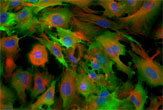
Scientists have found that a common type of human brain cell can transform into other cell types and reproduce indefinitely—tricks once thought exclusive to stem cells.
The mature human brain cells were extracted from epilepsy patients and coaxed into other types of brain cells in a lab. The human cells also transformed into different types of brain tissue when transplanted into the brains of mice.
The cells [image] were maintained for nearly a year without showing signs of aging or of mutations associated with cancer cells. The researchers predict that one cell could give rise to 10 quadrillion brain cells—enough to replace every cell in about 50 million adult brains.
"This is a completely new source of human brain cells that can potentially be used to fight Parkinson's disease, Alzheimer's disease, stroke and a host of other brain disorders," said study leader Dennis Steindler of the McKnight Brain Institute at the University of Florida.
The study is detailed in an online edition of the journal Development.
Brain support cells
The researchers extracted a common type of support cell in the brain called "glial cells" from the brains of patients undergoing surgery for epilepsy. In the human brain, glial cells are estimated to outnumber neurons by as much as 50 to 1.
Get the world’s most fascinating discoveries delivered straight to your inbox.
The cells were taken from the gray matter regions of the brains—an area not known for harboring stem cells.
When the cells were bathed in growth agents, they transformed into "neural progenitors," cells that are a bit further along in development than stem cells.
Whether in the lab or in the brains of mice, the human neural progenitor cells were able to morph into a variety of other cell types, including glial support cells like their parents and neurons.
"They seemed to be better at making neurons than they are at making glia," Steindler told LiveScience. "When they were transplanted into the brains of mice, they made some of the best looking transplant neurons I've seen in a long time."
Ben Barres, a neurobiologist at the Stanford University School of Medicine who was not involved in the study, said it was extremely important to show that cells could not only transform into other cell types, but that they could also survive when transplanted into animals.
"Now the question is what these cells do in a human brain. Will they be able to survive for the long term and rebuild circuitry? This work is a first step toward that end," Barres said.
Drug testers
Steindler said it's possible his team merely extracted already existent neural progenitor cells from the adult brains and placed them in environments where they could flourish. A more intriguing option, though, is that normal glial cells that were not inherently multipotent—that is, able to transform into other cell types—were made so through exposure to growth agents.
"My preference is the former, that we have de-differentiated these cells by our culture conditions and in a sense turned their clocks back, but that remains to be determined," Steindler said.
In addition to repairing or replacing damaged brain tissue, the cells could be useful in testing the safety and efficiency of new drugs. The cells could also be genetically modified to produce substances that help brain tissue survive, called neurotrophins, the researchers said.
- Adult Brain Cells Do Keep Growing
- Study: Your Brain Works Like the Internet
- Brain Breakthrough: Scientists Know What You'll Do
- Cloning Pioneer Envisions World Stem Cell Bank
- The Journey of a New Brain Cell
